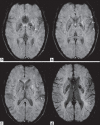Hemichorea-hemiballism syndrome: A look through susceptibility weighted imaging
- PMID: 21808477
- PMCID: PMC3141477
- DOI: 10.4103/0972-2327.82803
Hemichorea-hemiballism syndrome: A look through susceptibility weighted imaging
Abstract
Hemichorea-hemiballism syndrome (HCHB) is a relatively rare cause of unilateral chorea in diabetic patients and is due to non ketotoic hyperglycaemia. Characteristic magnetic resonance (MR) findings include T1 hyperintensity in the contralateral putamen without any significant signal alteration on other conventional MR sequences. We report susceptibility weighted imaging (SWI) findings in a case of HCHB syndrome.
Keywords: Diabetes; hemichorea-hemiballism; putamen; susceptibility.
Conflict of interest statement
Figures


References
-
- Cherian A, Thomas B, Baheti NN, Chemmanam T, Kesavadas C. Concepts and controversies in nonketotic hyperglycemia-induced hemichorea: Further evidence from susceptibility-weighted MR imaging. J Magn Reson Imaging. 2009;29:699–703. - PubMed
-
- Felicio AC, Chang CV, Godeiro-Junior C, Okoshi MP, Ferraz HB. Hemichorea-hemiballism as the first presentation of type 2 diabetes mellitus. Arq Neuropsiquiatr. 2008;66:249–50. - PubMed

